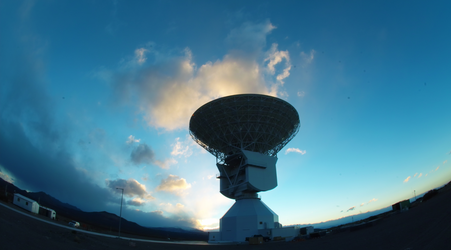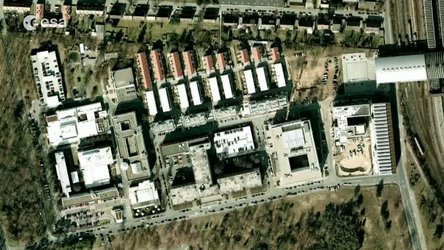ESA Ground Stations Live
ESA's tracking station network – Estrack – is a global system of ground stations providing links between spacecraft across the Solar System and ESOC, the European Space Operations Centre in Darmstadt, Germany.
The essential task of all ESA ground tracking stations is to communicate with spacecraft, transmit commands, and receive scientific data and spacecraft status information.
Below, you will find frequently updated outdoor webcam images from these ground stations. If the image is dark, it is night in that part of the world!
For more images from ESA Ground Stations, see the image gallery.
Deep Space Ground Stations
In order to to provide continuous coverage for communication with interplanetary spacecraft as Earth rotates, ESA established three giant, terrestrial 35 m Deep Space Antennas approximately 120° apart in longitude.
These antennas can track spacecraft almost anywhere – circling Earth, watching the Sun, orbiting at the scientifically crucial Sun-Earth Lagrange points, or voyaging deep out into our Solar System.
These first three webcam images show the 35 m-diameter dish antennas at the deep space ground stations located in Spain, Australia and Argentina.
New Norcia, Australia

The first live outdoor webcam image shows the antenna NNO1, or Deep Space Antenna 1 (DSA-1), at ESA's New Norcia deep space tracking station. The webcam runs 24 hrs per day and the image will automatically refresh every 5 minutes.
The New Norcia station is located 140 kilometres north of Perth, Western Australia, near the town of New Norcia: -31° 2' 53.61", +116° 11' 29.40"
NNO1 is a 35-metre deep-space antenna with transmission and reception in S- and X-band. It communicates with deep-space missions and provides support to spacecraft such as Mars Express, Rosetta and Gaia for routine operations.
The New Norcia ground station is now powered in part by sunlight, thanks to a solar power farm completed in August 2017. The farm has 840 photovoltaic panels with a rated capacity of 250 kW. It generates approximately 470 MWh, or 40% of the station’s annual electricity needs, which is similar to the electricity needed to power 134 typical households.
Cebreros, Spain

The live outdoor webcam image of the antenna CEB1, or DSA-2, at ESA's Cebreros deep space tracking station is shown above.
The webcam was switched on in September 2005 and was upgraded in September 2018. It will automatically refresh every 5 minutes and runs 24 hrs per day.
The 35 meter antenna at Cebreros, in the province of Ávila, is located only 50 minutes away from ESAC, the ESA Space Astronomy Centre in Villanueva de la Cañada, Madrid: +40° 27' 09.68", -04° 22' 03.18"
The Cebreros deep space tracking station was inaugurated in September 2005, in time to support the Venus Express mission. It is designed for deep-space satellite missions and provides daily support to Gaia, Mars Express and Exomars for routine operations, and supports the European-Japanese Bepi-Colombo mission to Mercury that launched in October 2018.
The Cebreros antenna incorporates state-of-the-art technology. CEB1 has a high data acquisition capacity, as it receives signals in the Ka band, K band and X band, and a high pointing accuracy, with a maximum error of 6.0 millidegrees.
Malargüe, Argentina

The outdoor webcam image of MLG1, or DSA-3, at ESA's Malargüe deep space tracking station is shown above. It was switched on in May 2010 and provides a new automatically refreshed image every 30 seconds.
The Malargüe station is ESA's newest tracking station, 30 km south of the city of Malargüe, approximately 1200 km west of Buenos Aires, Argentina, and situated 1550 m above sea level.: 35° 46' 33.63" S (35.776°S), 69° 23' 53.51" W (69.398°W)
MLG1 is a 35 m-diameter antenna with both transmission and reception in X-band and Ka-band, and reception in K-band.
It entered full service in early 2013, providing daily support to missions such as Venus Express, Mars Express, Herschel and Planck. Today, it supports Bepi-Colombo, Gaia, Mars Express and Exomars.
Malargüe is also home to the southern site of the Pierre Auger Observatory, an international physics experiment searching for ultra-high-energy cosmic rays.
A portion of MLG1's operating time is used by scientists in Argentina for radio astronomy and research.
15-Metre Antennas
ESA also operates three ground stations equipped with 15 m-diameter dish antennas to support missions orbiting Earth. These are located in Redu, Belgium, in Kourou, French Guiana, and in Kiruna, Sweden.
Redu, Belgium
 +50° 00' 01.64", +5° 08' 43.24".
+50° 00' 01.64", +5° 08' 43.24". The above webcam image shows the RED1 15 m dish antenna. RED1 is used to support the EU Galileo mission by sending commands to and receiving data from spacecraft in coordination with the Galileo Control Centre in Oberpfaffenhofen, Germany.
The station is part of ESEC, the ESA Security and Education Centre, which hosts more than 10 ESA antennas serving Galileo and the Proba-series of cubesats, as well as several antennas owned by the Belgian government and more than 35 antennas of the satellite telecommunications company SES.
The station provides tracking capabilities in L, S, X, Ku and Ka-band and supports in-orbit testing of telecommunication satellites.
Kourou + Kiruna

The remaining 15m antennas are located in Kourou, KRU1, and Kiruna, KIR1. Currently, there are no webcams at these ground stations.
Kourou station is located just 19 km from the Centre Spatiale Guiana (CSG), Europe's spaceport in French Guiana. Its 15 m antenna includes facilities for tracking, telemetry and radiometric measurements and can also provide system validation testing for satellites installed on their launcher at CSG prior to take off.
Kiruna station is located at Salmijärvi, 38 km east of Kiruna, in northern Sweden. It features two terminals, one with a 15 m antenna and one with a 13 m antenna, used to communicate with satellites in Earth orbit, including CryoSat-2, Integral, the Swarm trio and Sentinel-1A.

Launcher Tracking Stations
ESA operates three smaller dishes for tracking spacecraft during the crucial early stages of a mission following launch. Currently, there are no webcams situated at these stations.
Augmented Network
The ESA-owned and operated core Estrack network is complemented by commercially operated stations provided through service contracts with organisations such as the Swedish Space Corporation (SSC), Spain's National Institute of Aerospace Technology (INTA) and Kongsberg Satellite Services AS (KSAT, Norway).
These include tracking stations located at South Point, Hawaii (USA), Santiago (Chile), TrollSat, Antarctica, and Svalbard (Norway) and Dongara (Australia).
These stations are used especially during the LEOP phase of a mission immediately following launch, when the flight control team needs continuous communication with their satellite, beyond what can be provided by ESA's own stations.















 Germany
Germany
 Austria
Austria
 Belgium
Belgium
 Denmark
Denmark
 Spain
Spain
 Estonia
Estonia
 Finland
Finland
 France
France
 Greece
Greece
 Hungary
Hungary
 Ireland
Ireland
 Italy
Italy
 Luxembourg
Luxembourg
 Norway
Norway
 The Netherlands
The Netherlands
 Poland
Poland
 Portugal
Portugal
 Czechia
Czechia
 Romania
Romania
 United Kingdom
United Kingdom
 Slovenia
Slovenia
 Sweden
Sweden
 Switzerland
Switzerland




































